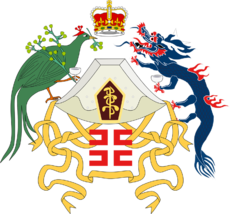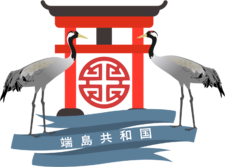Coat of arms of New Weihai
| The Coat of Arms of New Weihai | |
|---|---|
 | |
| Details | |
| Armiger | Elizabeth II in Right of New Weihai |
| Adopted | 10 May 2016 |
| Crest | St Edward's Crown and Moon |
| Escutcheon | Axe |
| Supporters | Fenghuang and Azure Dragon |
The coat of arms of New Weihai is the national symbol of the New Weihai City State. It was granted by the Governor-General, on behalf of Queen Elizabeth II in 2016, although she unrecognised her reign in New Weihai. The coat of arms is based on the ancient Chinese symbols of the Twelve Ornaments.
Design
The emblem is based on the ancient symbols of the Twelve Ornaments (十二章).
These are first mentioned as already ancient in the Book of Documents by Emperor Shun, who was one of the Chinese legendary Three Sovereigns and Five Emperors. Oral tradition holds that he lived sometime between 2294 and 2184 BCE. According to the book, the emperor wished for the symbols to be used on official robes of the state.
The symbols were considered most auspicious and therefore as a set were reserved only for the emperor to be shown on his ceremonial robes.
The coat of arms arranges these symbols in such a way to reflect the order of achievement in western heraldry, with the St Edward's Crown borne on top of the helm.
Symbols
- The supporter sinister is the azure dragon, which symbolizes strength and adaptability.
- On the back of the dragon is fire, which symbolises light and brightness.
- behind the head of the dragon is the crescent moon of the moon rabbit who is constantly pounding the elixir of life.
- The supporter dexter is a fenghuang, or pheasant-phoenix, and represents peace and refinement.
- The phoenix holds pondweed or algae in its right talon, a symbol of purity and brightness.
- behind its head are three stars, which could be the Fu Lu Shou stars, which symbolise happiness, prosperity, and longevity.
- Both creatures hold in one of each claws the zongyi (Chinese: 宗彝), which is a sacrificial cup, symbolising devotion and loyalty.
The dragon and phoenix represent the natural world. In yin and yang terminology, a dragon is male yang and the phoenix a female yin. The inclusion of the phoenix into the national symbol, opposite but equal to the dragon, can be seen as a symbol of women being equal to men, and a visual and poignant representation of women's rights in New Weihai.
- Featuring as the crest on top is the St Edward's Crown.
- In the middle functioning as the escutcheon is the axe head, which symbolises courage and resolution, but also justice. The blade of the axe head is pointing downwards, the head is shaped like a sloping mountain.
- Overlaid on the axe head are grains of rice, which symbolise nourishment and the country's agriculture.
- In the center of the axe head framed by a pentagon is a simplified symbol of a rice ear, which again stresses the importance of agriculture as the basis of the country's wealth and prosperity.
- The downward-pointing blade of the axe head features a hardened edge in shape of four mountains. These represent tranquility and steadiness.
The mountains represent earth, the cups metal, the pondweed water, the rice grains wood, and fire, which are all representations of wu xing.
- The figure 亞 fu underneath the axe represents two animals with their backside together. This symbolises the capability to make a clear distinction between right and wrong.
- The fu sign is in the middle of complex interlacing ribbons, which connect the dragon, the phoenix and the axe to each other.
Use
The coat of arms is the formal symbol of the New Weihai City State that signifies authority and ownership. The arms are used by New Weihai Government departments and agencies, statutory and non-statutory authorities, the Parliament and courts and tribunals. Members of Parliament (MP) may also use the arms in the course of their duties as Parliamentarians. The coat of arms should never be used where it could wrongly imply a formal guarantee, sponsorship or endorsement by the city-state. Use of the arms by private citizens or organisations is rarely permitted; however, there are provisions for use by sporting bodies and in educational publications. Use of the coat of arms without permission may be a criminal offense. The import of goods bearing the arms is also illegal.
 Hashima |
Planning areas
Bunam | Nishihira | Weipei | Kōtō Government President | Prime Minister | Cabinet | Parliament | Judiciary Political Parties Culture Languages | History | Arts | Literature | Music | Symbols | Holidays | Ceremonies | Dance Media Hashima Broadcasting Corporation | The Morning Post Misc Hashima Armed Forces | National Anthem of Hashima | Coat of arms of Hashima | Flag of Hashima |
|---|